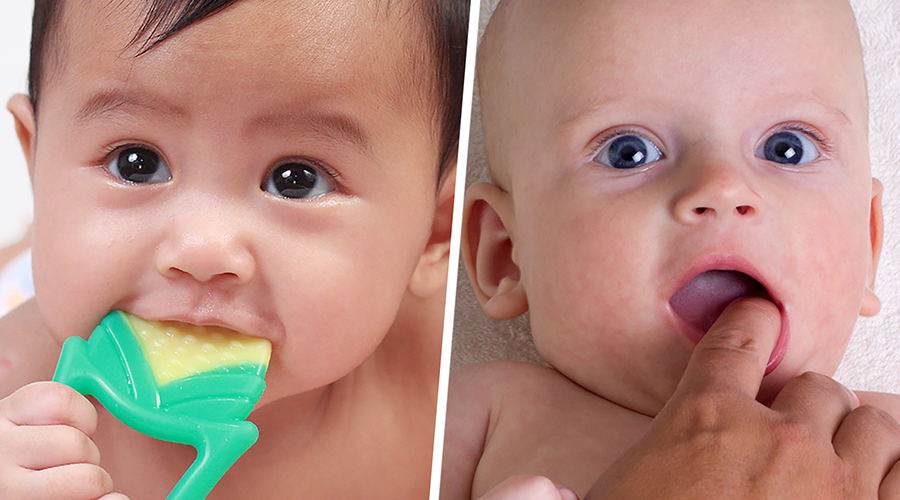How to Ease the Pain of Baby Teething
Español
Teething is normal but may be a painful experience for infants and toddlers. Too often, well-meaning parents and caregivers who desire to ease a child'south pain turn to medications and products that could exist harmful.
Soothing children'southward gums with prescription or over-the-counter (OTC) drugs, homeopathic drugs, or teething jewelry marketed for relieving teething pain may seem like good options. But those products can exist dangerous and tin can lead to serious injury or even death. This also applies to older children with special needs who may employ teething jewelry for sensory stimulation.
The American Academy of Pediatrics (AAP) recommends alternative ways for treating teething pain, including rubbing infants' gums with a clean finger or providing a teething band made of firm condom to chew on. For children with sensory stimulation needs, parents and caregivers should talk to their kid'south health care provider well-nigh safer options.
On boilerplate, children begin teething effectually 4 to seven months, and take a total of xx "babe teeth" by age 3. According to the AAP, occasional symptoms of teething include mild irritability, a low-level fever, drooling, and an urge to chew something difficult.
The Risks of Teething Bracelets, Necklaces and Other Jewelry
Teething jewelry includes necklaces, bracelets, and other jewelry worn by either an adult or child, used by parents and caregivers, and is marketed to relieve an infant'southward teething pain. It may also be marketed for utilise by people with special needs, such equally autism or attention deficit hyperactivity disorder, to provide sensory stimulation or redirect chewing on apparel or trunk parts.
The chaplet of the jewelry may be made with various materials such as amber, wood, marble, or silicone. Jewelry marketed for teething is not the same as teething rings or teethers, which are made of hard plastic or rubber and not wearable by an adult or child.
At that place are serious risks associated with using jewelry marketed for relieving teething pain such as choking, strangulation, injury to the mouth, and infection. Other concerns include potential injury to the mouth or infection if a piece of the jewelry irritates or pierces the child's gums.
Teething Creams and Gels Also Take Risks
Parents and caregivers might also look to relieve a teething baby by rubbing numbing medications on the child'southward gums. But the U.S. Food and Drug Administration (FDA) warns confronting using whatever sort of topical medication to treat teething pain in children, including prescription or OTC creams and gels, or homeopathic teething tablets. They offer footling to no benefit and are associated with serious risk.
Benzocaine — a local anesthetic — is the agile ingredient in several OTC oral wellness care products such as Anbesol, Infant Orajel, Cepacol, Chloraseptic, Hurricaine, Orabase, Orajel, and Topex. These products should non be used for teething because they can be dangerous and are non useful because they wash out of a baby'due south oral fissure inside minutes.
The apply of benzocaine gels, sprays, ointments, solutions, and lozenges for oral fissure and gum pain tin lead to a serious — and sometimes fatal — condition called methemoglobinemia, in which the oxygen-conveying capacity of red blood cells is greatly reduced.
Prescription and OTC benzocaine oral health care drug products are likewise widely used in adults. Doctors and dentists often use sprays containing benzocaine to numb the mucous membranes of the mouth and throat or to suppress the gag reflex during medical and surgical procedures, such as transesophageal echocardiograms, endoscopy, intubation, and feeding tube replacements. But benzocaine sprays are not FDA-approved for these uses.
Talk to your wellness care professional person well-nigh using benzocaine and other local anesthetics, peculiarly if yous take heart disease; are elderly; are a smoker; or have breathing bug such as asthma, bronchitis, or emphysema. Those weather put yous at greater risk for complications relating to methemoglobinemia.
What You Can Practice to Ease Teething Pain
If your child's gums are swollen and tender, gently rub or massage the gums with your finger, or give your child a teething band made of house rubber to chew. Make sure the teething ring is not frozen. If the object is too hard, it tin injure your child'southward gums. Parents should supervise their children and then they don't accidentally choke on the teething ring.
Parents and caregivers of children with special needs who may crave sensory stimulation should talk to their child'south health care provider about safer options and handling. Jewelry marketed for relieving teething pain and to provide sensory stimulation can lead to serious injuries, including strangulation and choking.
The FDA continues to closely monitor the use of teething jewelry and other teething hurting relief products and is evaluating whether other deportment are necessary to address the risks associated with these products, as part of its commitment to protecting public health – especially when information technology comes to the health and safety of children.
Consumers and health care professionals should notify the FDA of any adverse side effects when using drugs and devices the agency regulates, by reporting them online to MedWatch, the FDA'southward safety information and adverse event reporting program, or by telephone at 1-800-FDA-1088.
Source: https://www.fda.gov/consumers/consumer-updates/safely-soothing-teething-pain-and-sensory-needs-babies-and-older-children

0 Response to "How to Ease the Pain of Baby Teething"
Post a Comment